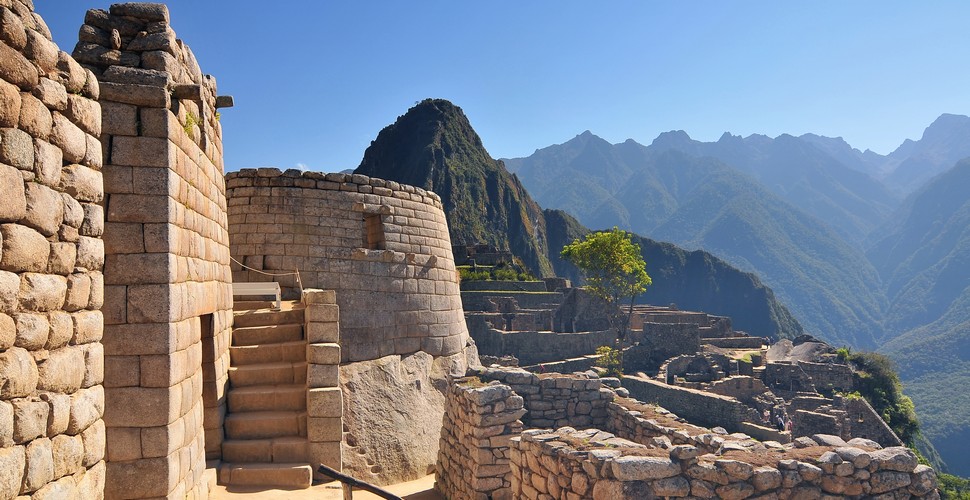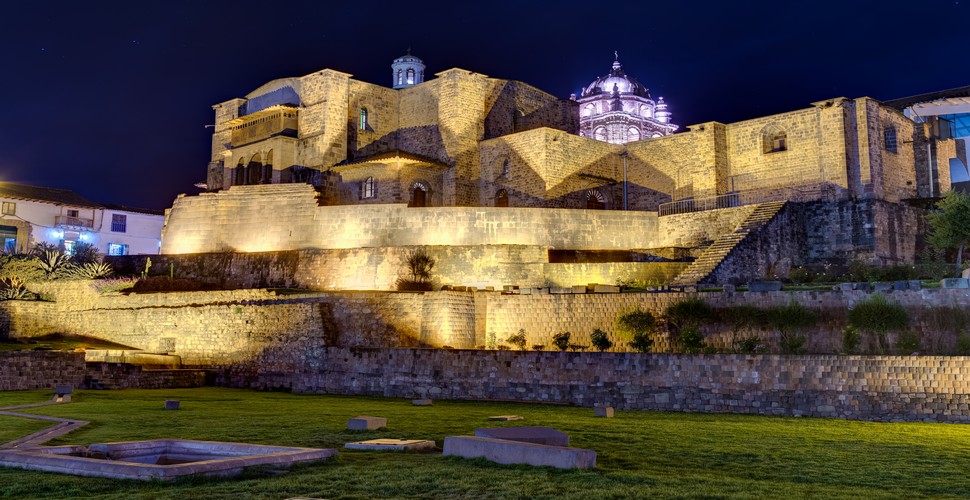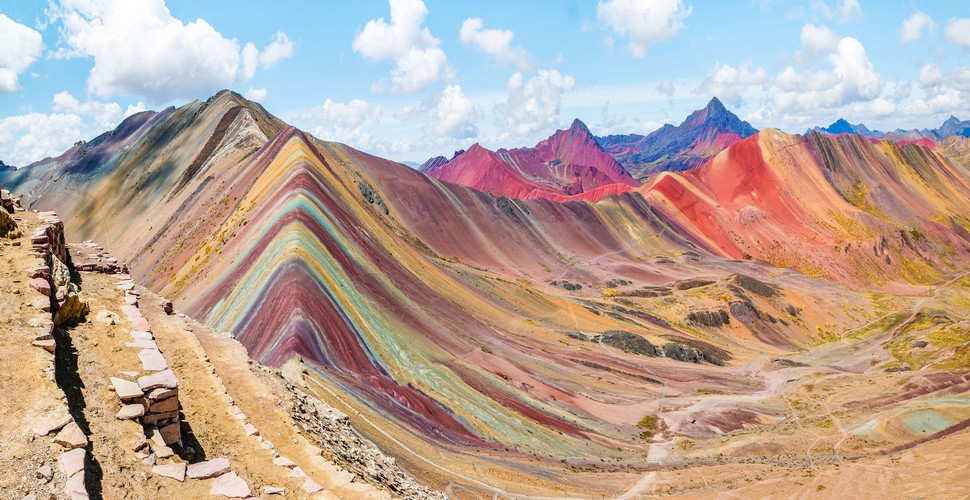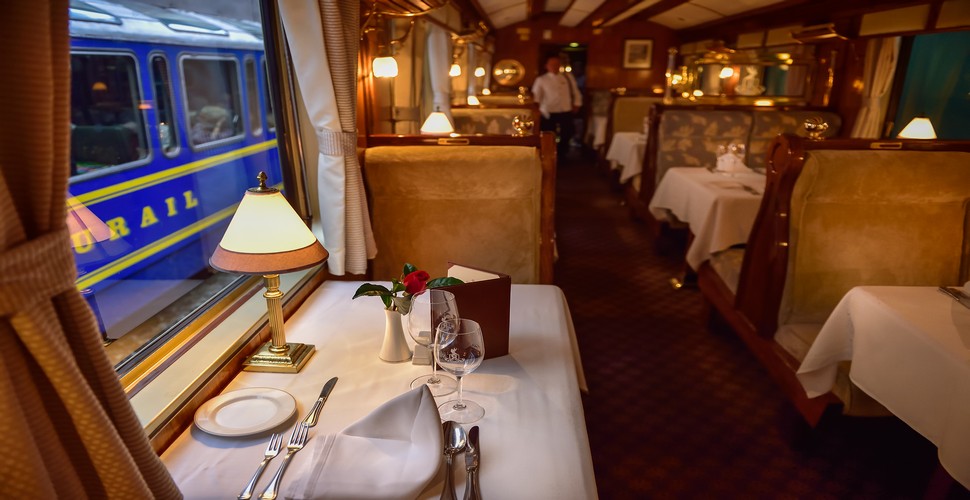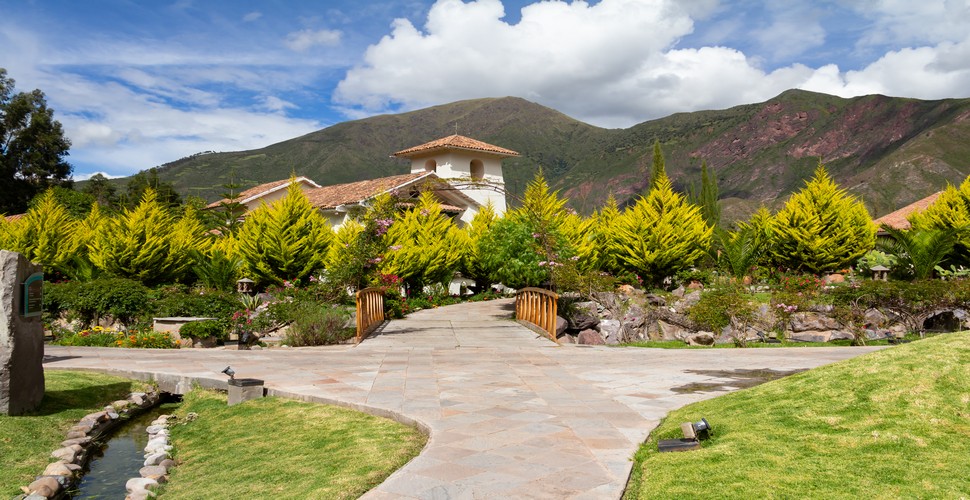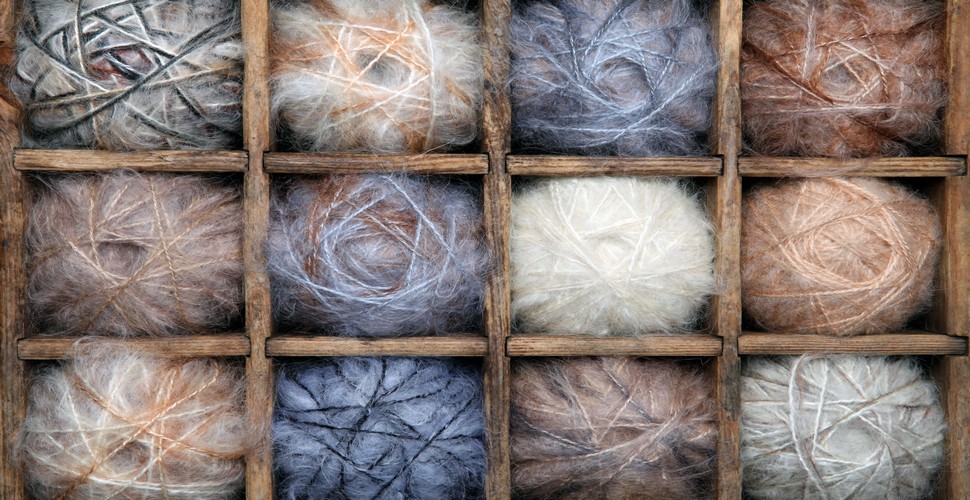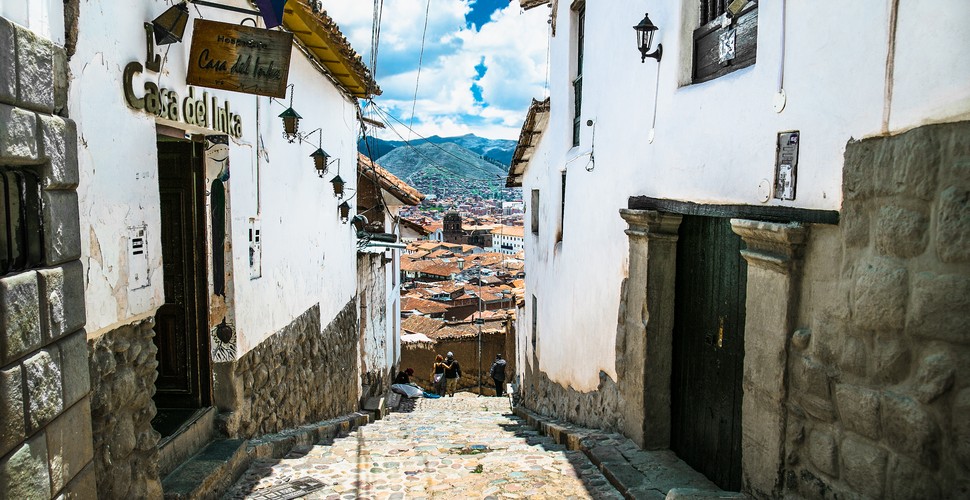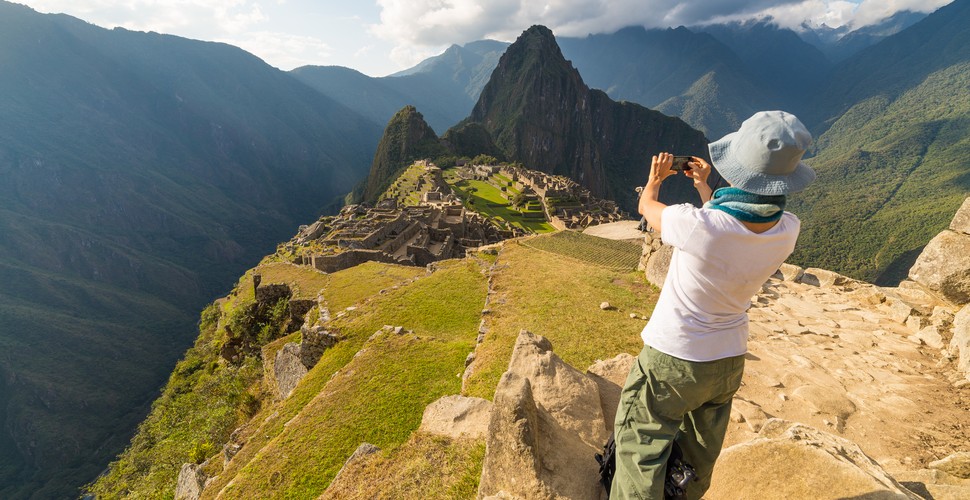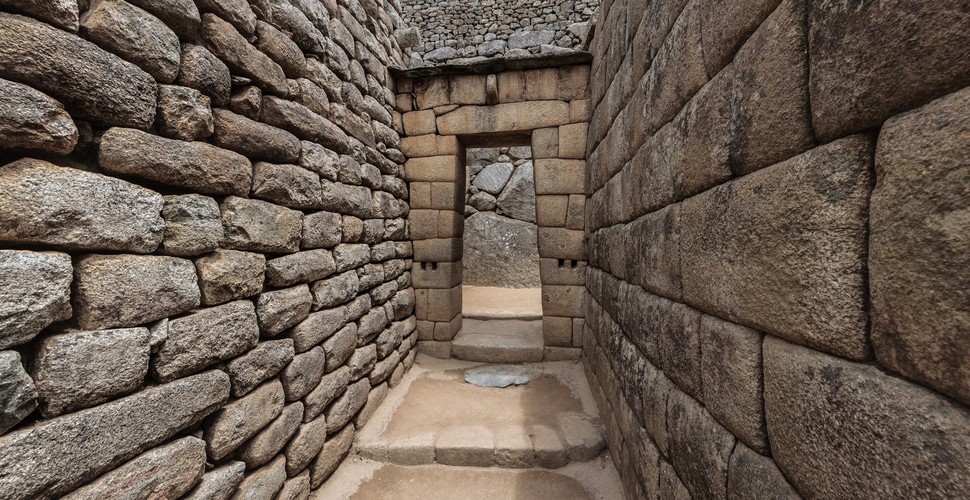
Machu Picchu Express
Written by:Valencia Travel
Last Update: 2025-02-12
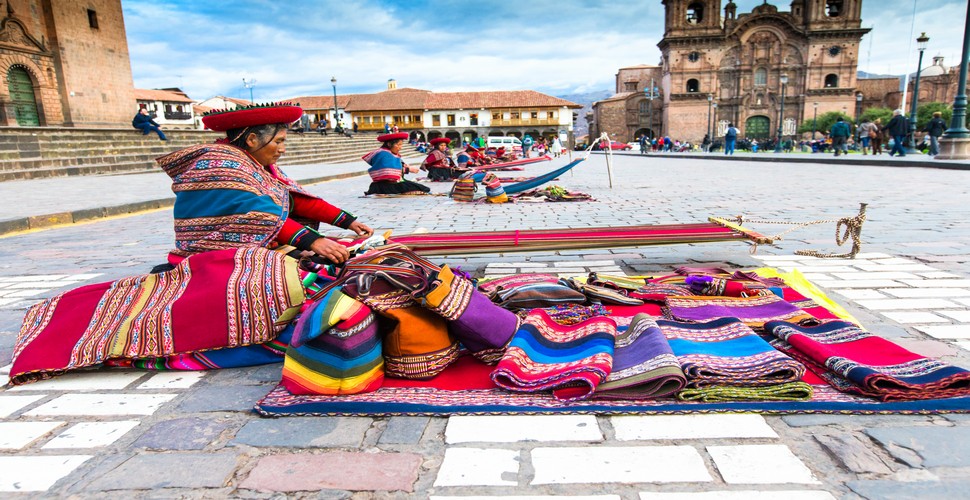
Quechuan weavers in the Plaza de Armas, Cusco
Main Features of Machu Picchu
When visiting the site, you will notice that the structures are built with dry stone walls in classical Inca style covering an area that consists of approximately 8sq km. Many of the buildings at Machu Picchu have been reconstructed using the original elements and dry Ashlar masonry techniques used by the original Inca builders. This technique called for precisely positioning oddly-shaped stones together like pieces from a jigsaw puzzle, with no mortar. As you’ll see when you visit, there are no spaces between the stones. The windows and doors have a unique trapezoidal outline that enhanced stability in this notoriously seismic region. In total, the complex consists of approximately 200 buildings, each with its specific purpose. Among the houses and smaller outbuildings, larger warehouses, and intriguing bathhouses, three major structures stand out. These are the Temple of the Sun (Torreon), the Intihuatana, and the Room of the Three Windows. Of these, the Torreon is perhaps the most impressive; it is an immense structure that may have doubled as an observatory. All three of the main structures on the mountain were dedicated to the sun god Inti. The site’s urban section is divided into an upper town and a lower town. As you may have guessed, the temples are located in the upper town. A massive square divides the ceremonial portion of the old citadel from the residential portion. The lower town was used for more mundane purposes; for example, you’ll find the remnants of warehouses there, along with simpler houses that were probably occupied by lower-class people. The entire site features massive terraces on which compounds were built. Stone stairways lead from one level to the next. In total, there are more than 3,000 stairs connecting the terraces to one another, and it’s easy to imagine ancient people going about their day-to-day business as you explore Machu Picchu.
Sun Temple, Machu Picchu
History of Machu Picchu
The first thing you should know about Machu Picchu is that it was built by the Incas, who were the largest empire in pre-Columbian America. They had a huge empire that stretched from Ecuador to Chile, and Machu Picchu was one of the many strongholds that they built. Incredibly, this pre-Columbian site is nearly intact, providing archaeologists with important clues about the people who lived there. Material and skeletal remains suggest that the massive fortress and its surrounding features were built as a royal retreat for Incan emperor Pachacuti, who lived between 1438 and 1472. Tupac Inca Yupanqui, who ruled between 1472-1493, is believed to have contributed to the site as well. Construction probably began around 1450. Evidence suggests that the royal estate was inhabited for just about 80 years before being abandoned – far shorter than many other Incan historic sites. While the mountainous retreat was never discovered by the Spanish conquistadors, historians theorize that abandonment occurred because of the conquests taking place in other parts of the Incan empire, or perhaps due to smallpox epidemics that occurred around the same time. Even though the site is close to Cusco Peru, the Spanish never found it as its location was somewhat difficult to get to and was a carefully guarded secret. The steep mountains that surround the royal compound, its town, and the terraced gardens were the ideal camouflage, serving as a natural fortress that prevented potential invaders from viewing the community from a distance.
7 Day Machu Picchu Express Tour
Trip Planning
One of the most important things to bear in mind on this 7 day trip is the altitude gain from Lima to Cusco. Altitude sickness is no joke and should not be taken lightly so on arrival to Cusco, drink a lot of water, get plenty of rest, and consider an altitude medication such as Diamox if you are planning a short trip. Visit your travel clinic or Doctor before you travel. You can also consume coca tea which is widely available in Cusco. Another good tip is to eat lightly and in smaller amounts as your digestion will slow down, so avoid, heavy greasy meals and definitely avoid alcohol for a few days. Drinking a cup of coca or muña tea in the morning and after a big meal is one of the local remedies for altitude-related stomach issues.
Packing for your trip to Machu Picchu, pack light and comfortable clothing, and a waterproof jacket (Machu Picchu is in a cloud forest!) Sunblock is very important, particularly in high-altitude destinations such as Cusco where you are a lot closer to the sun. a sun hat is also essential.
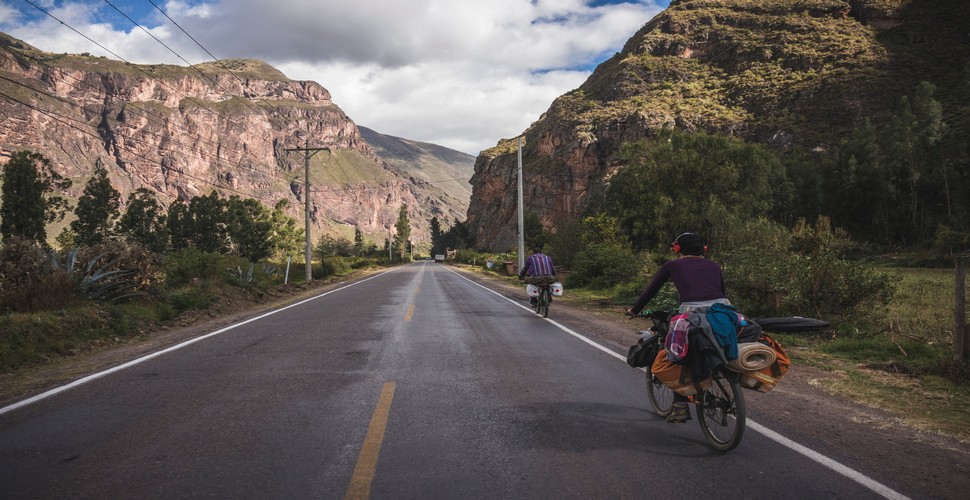
Cyclists in the Sacred Valley
Day 1 and 2 - Lima
Most Peru vacations start and finish in the capital, Lima. Lima, like any other capital city, is large and sprawling and you need to have your wits about you in certain areas, especially busy markets and on public transport. Most travelers head to Miraflores, Barranco, San Isidro, and La Molina for the safer areas of Lima. Miraflores is the most touristic region with high security, all categories of hotels, amazing restaurants, and all the facilities of any South American City. For a more bohemian, artsy kind of experience, head to Barranco. With art exhibitions, live music and great restaurants also. There is no better place to try Peruvian food than Lima. The incredible array of national dishes, fusion dishes, and international plates is incredible; however, when in Rome…you have to try the national dish of Ceviche and the other seafood dishes available. The main attractions in Lima are The Gold Museum, The Pachacamac ruins, the Water Park, Huaca Pucllana, ruins, The Plaza de Armas, The catacombs and the National Museum.
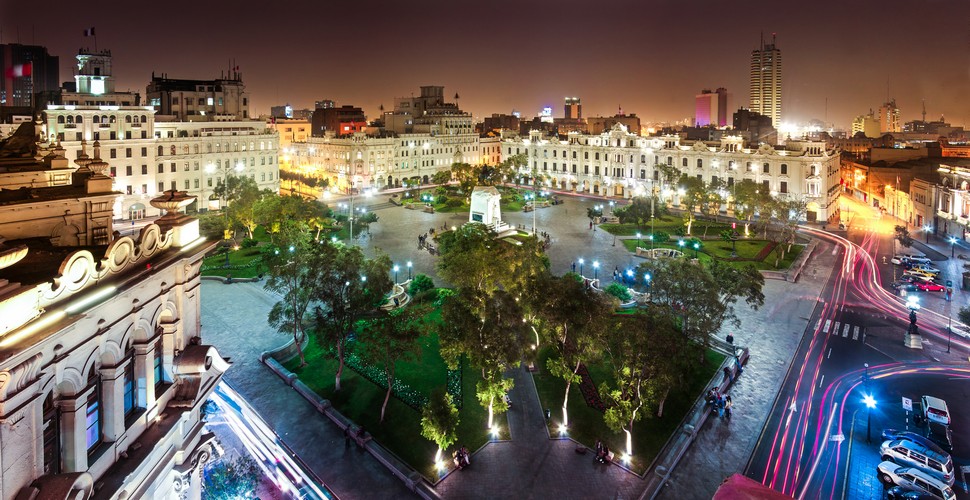
Plaza de Armas, Lima
Day 3 – Cusco
The Imperial City of Cusco was the center of the Inca empire and known as the “bellybutton of the world”. Its rich and complex history dates back thousands of years and to this day the city remains an eclectic mix of the traditional and the modern, full of history with a million and one stories to tell. The city is built on Inca foundations which are still visible today and are the base of many more modern buildings in the center. The historical center is the Plaza de Armas which is home to the cathedral, the Jesuit church, and a thousand street sellers, selling tours, shoeshines, massages, and handicrafts. The surrounding ruins of Saqsaywaman, Quenqo, Puka Pukara and Tambomachay are a great day trip and Cusco is the launching spot for the Sacred Valley and of course Machu Picchu. End your walking tour with a visit to the cathedral, where you can find painter Marcos Zapata’s famous painting of Leonardo da Vinci’s The Last Supper, with Guinea Pig as part of the feast.
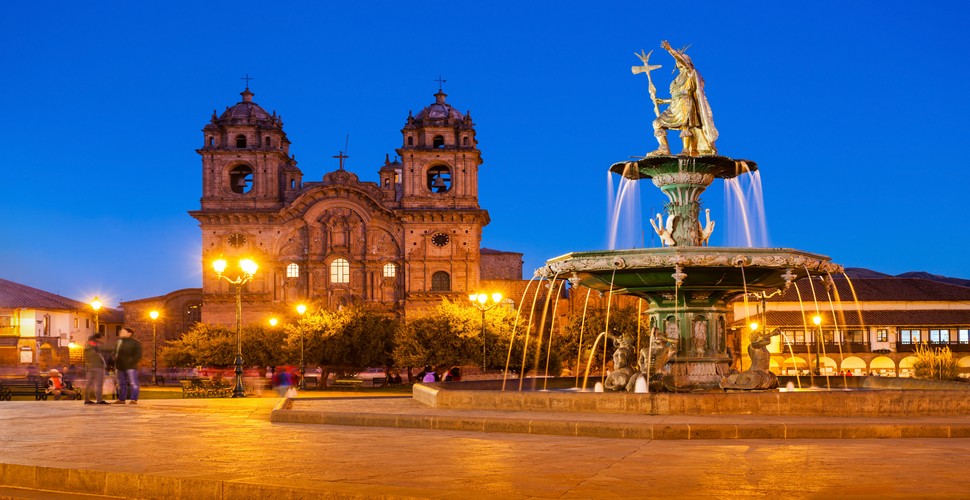
Plaza de Armas , Cusco
Day 4 – The Sacred Valley
The Sacred Valley apart from its stunning scenery is an incredibly fertile valley and such named by the Incas for this exact reason. The Vilcanota River brings to life to otherwise barren land, making this region more fertile than you would expect at this elevation. Chinchero, Ollantaytambo, and Pisac are the highlights of the Sacred Valley of the Incas. Pisac is a peaceful little town where you can visit a magnificent Inca fortress that sits in the hills above. The view of the Sacred Valley from the site is spectacular. Located only an hour away from Cusco and also home to a busy daily market, Pisac is one of the best day trips from Cusco.
From Pisac in the Sacred Valley, you continue downriver to Ollantaytambo, another picturesque town home of impressive archaeological sites, as well as horseback riding, rafting, and hiking tours.
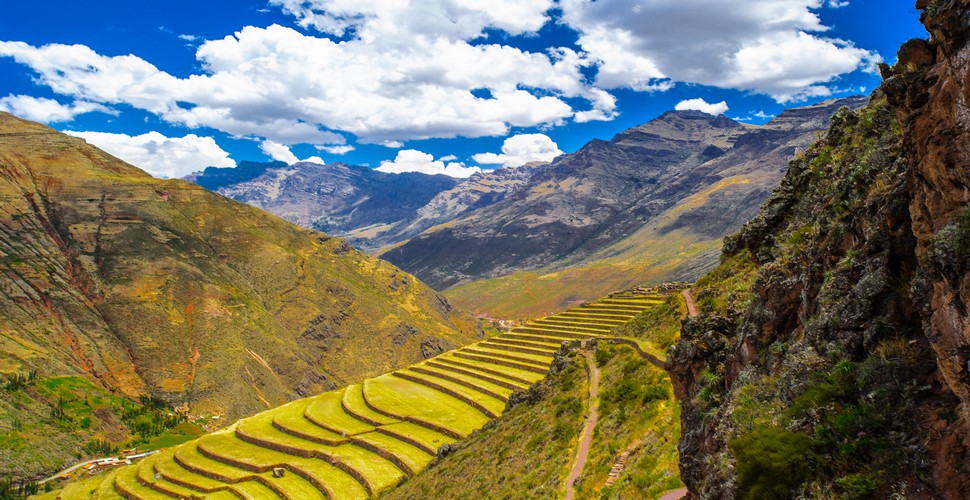
Pisaq Archaeological site
Day 5 – Aguas Calientes
Bright and early, you will take the train to Aguas Calientes, a small town at the base of Machu Picchu which is filled with bars, restaurants, and markets. We will head back to the town of Ollantaytambo for the picturesque train ride from Ollantaytambo, which is a one-and-a-half-hour trip through rolling countryside and Inca Andenes. On arrival in Aguas Calientes, you can choose to relax in your hotel, soaking in the thermal springs that give this town its name, or even check out a local butterfly sanctuary.
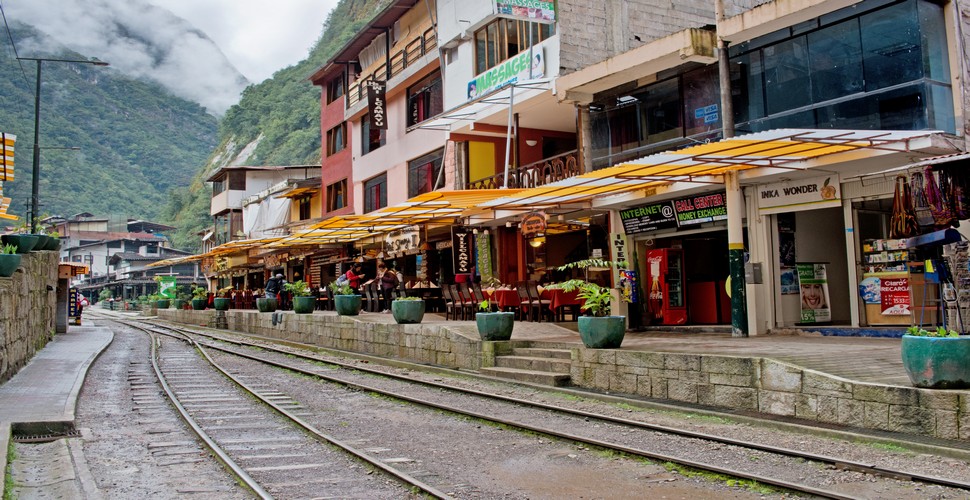
Aguas Calientes
Day 6- Machu Picchu
The next day, bright and early we will take the earliest bus from Aguas Calientes to Machu Picchu – at 5:30 am. By doing this, you can expect to be one of the first to arrive at the site, for an unforgettable experience. There is nothing quite like enjoying your first view of the ruins accompanied by little else than the sound of birdsong. For the best weather – and for a clear, unobstructed view of the site’s magnificent stones and temples.
Be aware when planning your trip to Machu Picchu that you must book tickets well in advance as there is a limit on the number of people who can enter the site per day. Your ticket gives you four hours within the grounds, and it generally takes around two hours to explore Machu Picchu. Note that it is mandatory to visit with a guide and the trails are now one-way circuits. It’s another couple of hours to your visit if you plan to hike up Huayna Picchu, too. Please note you’ll need to buy another entrance ticket to visit Huayna Picchu in order to do this. This hike is strenuous, but the views across the entire citadel are the highlight of any trip to Machu Picchu. Return to Cusco in the evening by train.
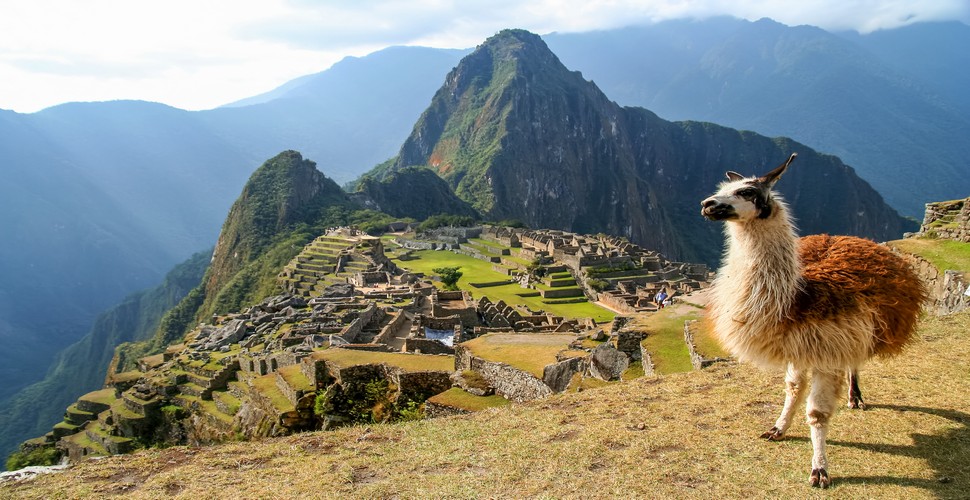
Machu Picchu
Day 7: Lima
Head back via plane to the capital city, Lima. Depending on the times of your flights, you can visit the bohemian Barranco neighborhood, home of chic cafes and bars in restored mansions, just a few steps away from the beach. This marks the end of this Peru express tour which will leave you simply wanting more, for your next visit to Peru!
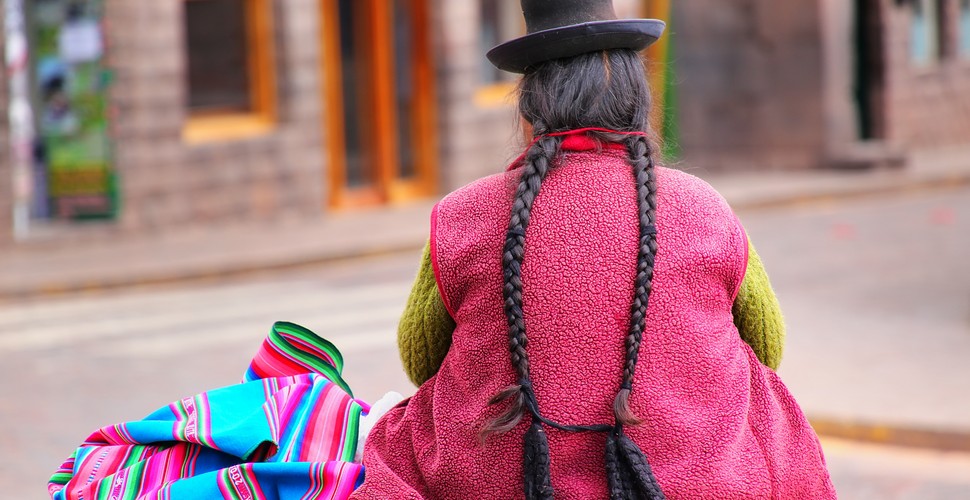
Cusco Street
The Luxury Machu Picchu Express Tour
Machu Picchu is an essential visit for anyone traveling to Peru, and despite the remote location, there is an exquisite way to spend your time at Machu Picchu in the lap of luxury. Here is why you should choose our luxury tour of Machu Picchu. Read on for more details!
Cusco
On arrival in Cusco, we will collect you from the airport and take you to the luxury hotel of your choice. Today we will be acclimatizing and getting acquainted with the Inca capital, Cusco, a stunning city Cusco, a stunning city that is full of incredible architecture (both Inca and colonial) as well as excellent restaurants and hotels. Get to know the real Cusco when you and your guide wander among the archaeological sites of Sacsayhuaman, an Inca fortress with magnificent Inca stonework, Qenqo ceremonial site, and Tambomachay Inca baths, with a setting to behold. Return to the city and roam the atmospheric streets of the bohemian neighborhood of San Blas, known as the city's artistic quarter. Explore the Inca temple of the sun - The Qoricancha, with the Santo Domingo church atop the Inca foundations and the centerpiece of the impressive Plaza de Armas, the cathedral.
Koricancha Temple of The Sun, Cusco
Rainbow Mountain
Located south of Cusco and in the province of Canchis is the amazing Vinicunca Mountain or Rainbow Mountain. Its impressive and brightly-colored natural prowess has made it an essential place to visit when in the area. You can reach this mountain in a group service at a cheap cost. We will head out in our private vehicle through magnificent Andean scenery to the town of Quesiuno, standing at 4326m elevation (14,189 ft), the trailhead for this day hike. It is a walk of approximately 2 hours with Andean flora and fauna all along the way and countryside panoramas that will leave you in awe. Our reward is the magnificent Rainbow Mountain standing at 5036 meters elevation with surrounding red mountains and scenery out of this world. After the classic photo opportunities, we will return to our vehicle with an incredible lunch amidst these beautiful mountains, prepared by our fantastic chef. A time to marvel at the wonders of nature while savoring gourmet cuisine in a mountain setting…. An unparalleled experience. Our return journey to Cusco will be a time of reflection on this unique and awe-inspiring rainbow-colored mountain, which will remain for years to come.
Rainbow Mountain
The Belmond Hiram Bingham To Machu Picchu
Our adventure continues with by far the most luxurious way to arrive at Machu Picchu. The Belmond Hiram Bingham runs between Cusco and Aguas Calientes, the town at the base of Machu Picchu; sip on pisco sours at the bar as you whizz through the region’s spectacular landscapes, enjoying brunch accompanied by a live performance from Peruvian musicians. After a guided tour of Machu Picchu with your expert guide, afternoon tea is served in the gardens at Belmond Sanctuary Lodge., the only hotel at the archaeological site. Spend the night here at this superb Sanctuary Lodge hotel before returning to the site the following day to see Machu Picchu in the morning light, and perhaps hike to one of the many viewpoints, including Huayna Picchu Mountain or Machu Picchu Mountain, or absorb the magical energies of this inspirational setting and Inca architecture. This evening you will spend the night in luxury in the heart of The Sacred Valley.
Hiram Bingham
The Sacred Valley
With your guide by your side, ascend the sloped terraces to the ruins of a centuries-old fortress above the town of Ollantaytambo, where the Incas secured a significant victory over the Spanish conquistadors. Inspect the intricately built stone constructions and have your guide show you the distant quarries from where the Incas sourced these huge stone blocks. This site also offers magnificent views of the valley and the Urubamba River that meanders through it. Our next port of call is Pisaq, with fantastic ruins above the town and an incredible, traditional market in the quaint village below. The perfect place to buy authentic souvenirs from your impressive journey through the land of the Incas. We will head back to your luxury hotel in Cusco for your final evening of fine dining and exquisite comfort in The Inca capital.
Sacred Valley Hotel
The tour ends with your airport pick-up when you will take your flight back to the capital Lima, reflecting on a magical and awe-inspiring trip to the Inca citadel of Machu Picchu, a luxurious experience throughout and a few surprises to make this the trip of a lifetime. Contact us for more information about this inspirational luxury journey to Machu Picchu, which few people experience and will remain with you forever.
Baby Alpaca Wool
3 Day Machu Picchu express
Another Express Machu Picchu option is our 3 day Machu Picchu Express. The historical capital of the Inca Empire is rich in history and culture, and there are plenty of opportunities to explore Inca ruins, eat delicious food, or shop for colorful textiles around town. Cusco is home to some of the world’s most iconic archaeological sites, such as Sacsayhuaman, Q’oricancha, and Machu Picchu. These ruins are a must-see for any history lover, and they offer a glimpse into the fascinating culture of the Incas. Cusco is located in the Andes Mountains, which means that it is surrounded by some of the most breathtaking scenery in the world.
San Blas Street, Cusco
Whether you plan to in the nearby mountains or simply explore the city, you’ll be sure to be impressed by the natural beauty of Cusco. The main square in Cusco, Plaza de Armas is a lively and vibrant place to spend an afternoon. The square is surrounded by colonial-era buildings, including the Cathedral of Cusco, which was built in the 16th century. There are also plenty of restaurants and cafes where you can enjoy a bite to eat or people-watch.
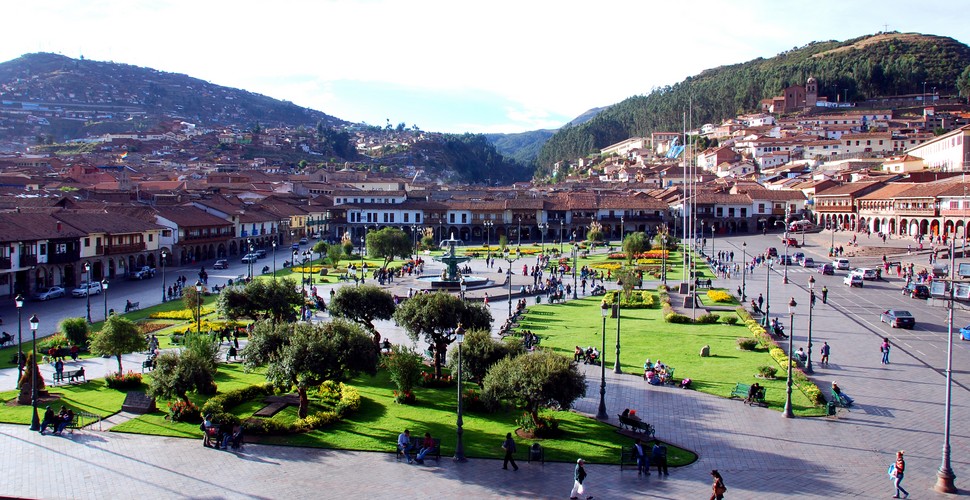
Plaza de Armas, Cusco
Machu Picchu
Today we will take a drive through the stunning Sacred Valley of The Incas to the town of Ollantaytambo, where you will board the train to Aguas Calientes. This is the starting point for the Machu Picchu visit that most people take and a visit to Machu Picchu inevitably means a visit to Aguas Calientes at some point! This 3-day Machu Picchu Express tour will take you by bus up to the iconic archaeological site for an afternoon visit to Machu Picchu. The main advantage of the Machu Picchu visit in the afternoon is that there are much fewer people visiting so you can completely appreciate this magnificent Inca site with fewer people.
Empty Machu Picchu
This modern wonder of the world is one of the highlights of visiting Peru with over 1 million tourists coming every year, and for good reason. It’s staggeringly beautiful, steeped in history, and is one of the best-preserved archeological sites from the Incan empire. It’s situated on a mountain ridge above the Sacred Valley of the Incas and is surrounded by lush vegetation and stunning views. Machu Picchu is one of the New Seven Wonders of the World and is located in the Urubamba region of the Cusco Province. It was built on a ridge between two peaks: Machu Picchu Mountain and Huayna Picchu. The ancient city of Machu Picchu has an elevation of 2,430 meters (7,970 feet) and consists of more than 150 buildings. These include temples, palaces, baths, storage rooms, and residential houses. It’s the most well-known and best-preserved example of Inca architecture in Peru. It’s no surprise it’s also a UNESCO World Heritage Site.
Entrance Door in Machu Picchu
So, now you know more about the different Machu Picchu express options for your Peru visit. If you are in a hurry, want a whistlestop tour of Machu Picchu, or prefer a more luxurious experience on your trip to Machu Picchu, Valencia Travel has got you covered! Contact us here for more information!
 Aventure
Aventure
 Cultural
Cultural
 Gastronomy
Gastronomy
 Wellness
Wellness
 Local Living
Local Living
 Luxury
Luxury
